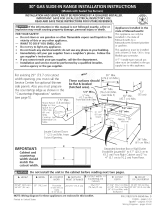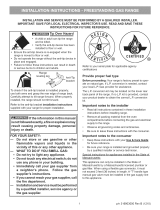
2
30" GAS SLIDE-IN RANGE INSTALLATION INSTRUCTIONS
(Models with Sealed Top Burners)
Installation of this range must conform with local codes
or, in the absence of local codes, with the National Fuel
Gas Code ANSI Z223.1/NFPA .54-latest edition.
This range has been design certified by CSA
International. As with any appliance using gas and
generating heat, there are certain safety precautions
you should follow. You will find them in the Use and
Care Guide, read it carefully.
• Be sure your range is installed and grounded
properly by a qualified installer or service
technician.
• This range must be electrically grounded in
accordance with local codes or, in their absence,
with the National Electrical Code ANSI/NFPA No.
70—latest edition. See Grounding Instructions.
• Air curtain or other overhead hoods, which operate
by blowing a downward air ow on to a range, shall
not be used in conjunction with gas ranges other
than when the hood and range have been designed,
tested and listen by an independent test laboratory
for use in combination with each other.
• Before installing the range in an area covered with
linoleum or any other synthetic oor covering,
make sure the oor covering can withstand heat
at least 90°F above room temperature without
shrinking, warping or discoloring. Do not install the
range over carpeting unless you place an insulating
pad or sheet of ¼" (0,64 cm) thick plywood between
the range and carpeting.
• Make sure the wall coverings around the range
can withstand the heat generated by the range.
• Do not obstruct the ow of combustion air at the
oven vent nor around the base or beneath the
lower front panel of the range. Avoid touching the
vent openings or nearby surfaces as they may become
hot while the oven is in operation. This range requires
fresh air for proper burner combustion.
Ne ve r l e a v e c hi ld r e n al on e o r
unattended in the area where an appliance is in use.
As children grow, teach them the proper, safe use of all
appliances. Never leave the oven door open when the
range is unattended.
Stepping, leaning or sitting on the
doors or drawers of this range can result in serious
injuries and can also cause damage to the range.
• Do not store items of interest to children in
the cabinets above the range. Children could be
seriously burned climbing on the range to reach items.
• To eliminate the need to reach over the surface
burners, cabinet storage space above the
burners should be avoided.
• Adjust surface burner ame size so it does not
extend beyond the edge of the cooking utensil.
Excessive ame is hazardous.
• Do not use the oven as a storage space. This
creates a potentially hazardous situation.
• Never use your range for warming or heating the
room. Prolonged use of the range without adequate
ventilation can be dangerous.
• Do not store or use gasoline or other ammable
vapors and liquids near this or any other
appliance. Explosions or res could result.
• In the event of an electrical power outage, the surface
burners can be lit manually. To light a surface burner,
hold a lit match to the burner head and slowly turn
the Surface Control knob to LITE. Use caution when
lighting surface burners manually.
• Reset all controls to the "off" position after using
a programmable timing operation.
FOR MODELS WITH SELF-CLEAN FEATURE:
• Remove broiler pan, food and other utensils
before self-cleaning the oven. Wipe up excess
spillage. Follow the precleaning instructions in the
Use and Care Guide.
• Unlike the standard gas range, THIS COOKTOP
IS NOT REMOVABLE. Do not attempt to remove the
cooktop.
A child or adult can tip the range and •
be killed.
Verify the anti-tip device has been •
installed to oor or wall as per
installation instructions.
Tip Over Hazard
Ensure the anti-tip device is re-engaged to oor or •
wall when the range is moved.
Do not operate the range without the anti-tip device •
in place and engaged.
Failure to follow these instructions can result in •
death or serious burns to children and adults.
To check if the anti-tip bracket is installed
properly, use both arms and grasp
the rear edge of range back. Carefully
attempt to tilt range forward. When
properly installed, the range should not
tilt forward.
Refer to the anti-tip bracket installation instructions
supplied with your range for proper installation.
This manual contains important safety symbols and instructions. Please pay attention to these symbols and
follow all instructions given.
This symbol will help alert you to situations that may cause serious bodily harm, death or
property damage.
This symbol will help alert you to situations that may cause bodily injury or property
damage.
IMPORTANT SAFETY INSTRUCTIONS















